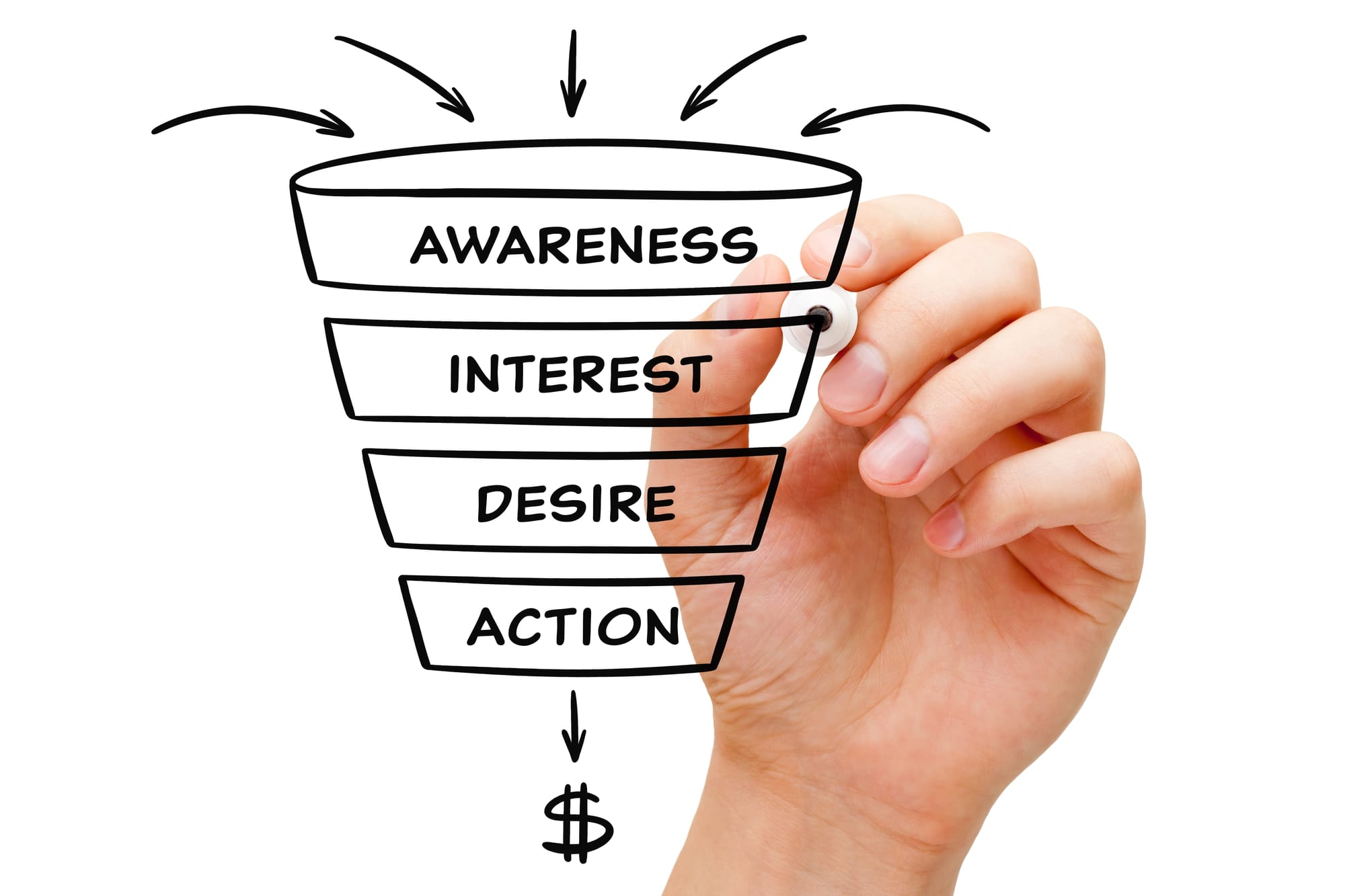A B2B sales funnel is a lot like a map. It charts the journey of your buyer from the beginning through to the end. Without that map, the path can seem confusing and dark. Buyers can even get lost, never to be seen again. With that map? Buyers safely navigate their way to their destination. The purchase point.
This article shares the ins and outs of a B2B sales funnel. We explore each core stage, the reasoning behind using a sales funnel, and some strategies that you can put in place to develop your own.
- What Are The Stages Of A B2B Sales Funnel?
- Why Develop A B2B Sales Funnel?
- What’s The Difference Between A B2B and B2C Sales Funnel?
- B2B Sales Funnel Strategies
What Are The Stages Of A B2B Sales Funnel?

A typical B2B sales funnel has 5 stages to it. You’ll sometimes see examples of B2B sales funnels with more or fewer stages, but the 5-stage example is the most commonplace option.
The 5 stages are:
- Awareness
- Interest
- Consideration
- Evaluation
- Purchase
The Awareness Stage
Awareness doesn’t refer to their awareness of you but rather your prospect’s awareness that there’s a problem that requires a solution. They have realized that they’d like to be rid of this issue. At this point, they have no real idea what solutions are out there or what that solution might look like. They’re simply aware that there’s an issue.
The Interest Stage
As the prospect begins to think more about their problem, they begin to discover that there are certain solutions out there that could help them. These typically come in the form of different products or services. They won’t have focused on actual suppliers but are forming an idea in their mind of what a perfect product might look like.
The Consideration Stage
Prospects now have a clear idea of what they’re looking for and are actively looking to find a supplier. They might begin to search online, visit business websites, request additional information, and possibly reach out to some vendors.
The Evaluation Stage
When a prospect reaches the evaluation stage, they’ve begun to create a small pool of potential suppliers. They know that these options are going to resolve their issue, address their pain points, and solve their problems. The question now is which?
The Purchase Stage
Also called the decision stage, the purchase stage is exactly as you’d expect. The prospect makes their decision and completes a purchase.
These funnel stages represent the typical journey that a buyer will go through. It’s important to note that these funnels aren’t always linear. Some people enter lower down the funnel. Others might move back to an earlier stage or even skip a stage.
You might also see the funnel broken down into 3 core stages. The top, middle, and bottom of the funnel. This is especially prevalent when talking about content marketing and advertising strategies. It’s a far simpler version to understand and attributes each stage to a different department.
The top of the funnel is typically about building awareness through marketing.
The middle of the funnel is where buyers consider their options and receive outbound contact from businesses.
The bottom of the funnel is the decision stage, where sales teams push for conversions.
Why Develop A B2B Sales Funnel?

Sales funnels are great at adding some structure to your business’s sales system, but there are many more benefits besides that:
Develops Brand Awareness
The more visible your brand is across the sales funnel stages the less risky your business seems as an option. If your name was being floated around during the Interest stage, someone is far more likely to consider you as an option now. Especially when compared to if you appeared at the consideration stage.
Higher ROI Levels
When a prospect enters your sales funnel, and you properly record their information into a CRM, you’re looking at them as a long-term option. Even if they don’t use your business the first time, you have the opportunity to continue to market to them (as if they hadn’t made a decision).
That means the door is never shut, and if they do decide to use your business in the future, they will already be a relationship there.
Easy To Track Performance
Each stage of the B2B sales funnel comes with its own set of key performance indicators and other core metrics. When these are accurately tracked, you’re able to evaluate performance within each department on a more holistic level. You can then address where there are gaps or improvements required.
You’ll Get To Know Your Audience
When you focus on the stages of your B2B funnel, you naturally learn more about your ideal customer. This, in turn, influences what you feel is your perfect buyer persona. The more you get to know this concept, the better your understanding and insight will be.
Useful For Your SEO Strategy
Your teams will develop content for the various stages of the funnel. That content all helps your SEO. The more valuable, authoritative, expert content that you’re able to share online, the more fondly search engines will look at your website. Better SEO means less spending on other expensive lead-generation methods.
What’s The Difference Between A B2B and B2C Sales Funnel?
Surely a sales funnel is a sales funnel? Just because the buyer is a business, what could the difference be?
You’d be forgiven for asking questions such as these, and there certainly is a great degree of similarities between the two. There are, however, a number of crucial differences that it’s worth paying attention to. Especially when setting up a B2B sales funnel.
Firstly, sales cycles tend to take considerably more time when buying through a business. It’s not unusual for some purchases to take upwards of 12 months. Often the evaluation stage is the trickiest to get businesses through.
These journeys are slower due to the larger number of stakeholders involved in the decision-making process. In a B2C funnel, you usually only have to convince the individual consumer. When working with a business, you need to get acceptance from multiple people.
Businesses will also request a more hands-on approach. Many B2C sales funnels can be journeyed entirely by the user and the content available on your website. Many sales will complete without a single verbal interaction between the business and the consumer. B2B is less the case.
Buyers will request demonstrations, meetings, and support. They like to feel that the seller is giving them their time and that they’re a worthy partner for the long term.
B2B Sales Funnel Strategies
It’s fair to say that what works well for one business won’t necessarily work as well for another. There are, however, some staples that can be used in some shape or form for the majority of businesses. These strategies will help to flesh out your sales funnel, guide your prospects, and help you convert them into purchasers.
Email Outreach
Cold emailing is a great B2B lead generation strategy. When the recipient receives your email they could enter the funnel at any of the stages. They might not be aware that they have the problem at all, so you’re developing awareness. There’s also the chance that they’re already evaluating their options, you might be able to entice them just in time.
The key is to provide valuable content for each stage of the funnel. Using automated sequencing, you can guide a user through the funnel toward purchase without lifting a finger. It’ll require a sophisticated email marketing tool, but when set up you’ll appreciate the outcomes. The best will even include cold email templates for B2B.
Content Marketing
Creating content for every stage of the B2B sales funnel is something that every B2B business should be doing. The content aims to answer questions that the user has. This isn’t just convenient for the user, but also saves your team valuable time.
In an ideal world, you’d produce content across multiple formats. That way your content appeals to the widest possible audience.
SEO
SEO should be a dedicated part of your sales funnel strategy. The content you create should serve to provide solutions to pain points that buyers have. Those buyers are likely to search online for their answers, and that’s where your content should be found. Precisely at those moments of questioning and consideration.
Customers will begin to spot your content during online searches. That means they will naturally begin to trust your brand and build an affinity with your business. Making the later stages of the funnel considerably easier to navigate.
Key Takeaways
Building an effective B2B sales funnel should be a priority for any business that sells to other businesses. It’ll give focus to your team, build structure into your processes, and help get your name out there. Just remember that sales funnels shouldn’t be seen solely as the linear model that they are often presented as. Be prepared to adapt yours as your business necessitates and you’ll find success.
- Potential buyers could enter at any stage of the funnel but most start at the awareness stage.
- There are 5 core stages to a sales funnel, but some models reduce this to 3.
- If you’re used to B2C funnels, prepare yourself for a slower ride with a B2B funnel.
Sales funnels are only as good as their constituent parts. One core part of that funnel should be email outreach. Embarking on that strategy means you’ll need a quality email tool to manage the thousands of emails that you’ll send and follow up on. Instantly is that tool and you can sign up for free today.





